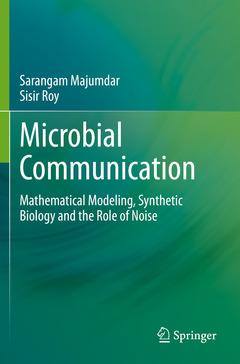Microbial Communication, 1st ed. 2020 Mathematical Modeling, Synthetic Biology and the Role of Noise
Auteurs : Majumdar Sarangam, Roy Sisir

This book introduces the concept of bacterial communication systems from a mathematical modeling point of view. It sheds light on the research undertaken in the last three decades, and the mathematical models that have been proposed to understand the underlying mechanism of such systems. These communication systems are related to quorum sensing mechanisms and quorum sensing regulated processes such as biofilm formation, gene expression, bioluminescence, swarming and virulence.
The book further describes the phenomenon of noise, and discusses how noise plays a crucial role in gene expression and the quorum sensing circuit operationusing a set of tools like frequency domain analysis, power spectral density, stochastic simulation and the whitening effect. It also explores various aspects of synthetic biology (related to bacterial communication), such as genetic toggle switch, bistable gene regulatory networks, transcriptional repressor systems, pattern formation, synthetic cooperation, predator-prey synthetic systems, dynamical quorum sensing, synchronized quorum of genetic clocks, role of noise in synthetic biology, the Turing test and stochastic Turing test.
Elaborates on all the different kinds of microbial communication systems
Describes the role of noise in the context of microbial communication
Provides insights into the mathematical models, experimental observations, synthetic biology and the relevance of quantum theory in understanding microbial communication
Date de parution : 09-2021
Ouvrage de 175 p.
15.5x23.5 cm
Date de parution : 09-2020
Ouvrage de 175 p.
15.5x23.5 cm



